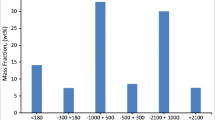Abstract
In the present study, the leachability of traced elements from the bottom ash of three different Indian power plants was investigated. Environmental impact of bottom ash was studied by varying the liquid-to-solid (L/S) ratio from 20:1 to 60:1. Leaching results show the presence of a major proportion of elements Mn, Mg, Cr, Zn and Cu and a minor proportion of Pb, Fe, Co, and Mo. The effect of the addition of sodium bicarbonate (NaHCO3) on leaching characteristics of bottom ash was also studied. Leaching concentration of bottom ash samples reduces with addition of additive from 0.2% to 0.6% and found to be optimum with 0.4% the addition of additive. This aspect of the investigation helps to design the ash disposal system for higher solid concentrations to minimize the environmental pollution.







Similar content being viewed by others
References
Bhatnagar M, Chouhan P (2012) Environmental evaluation of leaching of trace elements from fly ash from some thermal power stations in Rajasthan. J Biol Chem Res 29(2):224–229
Blissett R, Rowson N (2012) A review of the multi-component utilization of coal fly ash. Fuel 97:1–23
Hower JC, Sakulpitakphon T, Trimble AS, Schram WH (2006) Major and minor element distribution in fly ash from a coal-fired utility boiler in Kentucky. Energy Source 28:79–95
Jurkovic L, Hiller E, Veselska V, Petkova (2011) K Arsenic concentrations in soils impacted by dam failure of coal-ash pond in Zemianske Kostolany, Slovakia. Bull Environ ContamToxicol 86:433–437
Kim HK, Lee HK (2011) Use of power plant bottom ash as fine and coarse aggregates in high-strength concrete. Constr Build Mater 25(2):1115–1122
Kumar S, Kumar K, Gupta M (2016) Characterization of heavy metal trace elements in the fly ash from a thermal power plant. Energy Part A 38(16):2370–2376
Nayak AK, Raja R, Rao KS, Shukla AK, Mohanty S, Shahid M, Tripathi R, Panda BB, Bhattacharyya P, Kumar A, Lal B, Sethi SK, Puri C, Nayak D, Swain CK (2015) Effect of fly ash application on soil microbial response and heavy metal accumulation in soil and rice plant. Ecotoxic Environ Saf 114:257–262
Pani GK, Rath P, Maharana L, Barik R, Senapati RK (2016) Assessment of heavy metals and rheological characteristics of coal ash samples in presence of some selective additives. Int J Environ Sci Technol 13:725–731
Popovic A, Djordjevic D (2009) pH-dependent leaching of dump coal ash retrospective environmental analysis. Energy Source 31:1553–1560
Singh G, Kumar S, Singh MK, Mohapatra SK (2016) Environmental impact assessment of ash disposal system of a thermal power plant. Int J Hydrog Energy 41:15887–15891
Singh G, Kumar S, Mohapatra SK, Kumar K (2017) Comprehensive characterization of grounded bottom ash from Indian thermal power plant. J Resid Sci Technol 14(1):1–10
Sultana P, Das S, Bagchi B, Bhattacharya A, Basu R, Nandy P (2011) Effect of size of fly ash particle on enhancement of mullite content and glass formation. Build Mater Sci Process 34:1663–1670
Tsiridis V, Petala M, Samaras P, Kungolos A, Sakellaropoulos GP (2012) Environmental hazard assessment of coal fly ashes using leaching and ecotoxicity tests. Ecotoxic Environ Saf 84:212–220
Ugurlu A (2004) Leaching characteristics of fly ash. EnvGeol 46:890–895
United States Environmental Protection Agency (1987) Characterization of municipal waste combustor ashes and leachates from municipal solid waste landfills and co-disposal sites, I–VII, 530- SW-87-028A-E, Washington, DC, USEPA
Viji R, Prasanna PR (2011) Assessment of water holding capacity of major soil series of Lalgudi Trichy. Ind J Env Res Dev 7(1A):393–398
Xu Y, Chen Y (2015) Leaching heavy metals in municipal solid waste incinerator fly ash with chelator/biosurfactant mixed solution. Waste Manag Res 33(7):652–661
Zhang H, Sun L, Sun T (2012) Leaching of heavy metals from artificial soils composed of sewage sludge and fly ash. Bull Environ Contam Toxicol 88:406–412
Author information
Authors and Affiliations
Corresponding author
Rights and permissions
About this article
Cite this article
Singh, G., Kumar, S. & Mohapatra, S.K. Potential Risk by Disposal of Bottom Ash from Thermal Power Plants and Minimization by Addition of NaHCO3. Bull Environ Contam Toxicol 101, 773–778 (2018). https://doi.org/10.1007/s00128-018-2469-3
Received:
Accepted:
Published:
Issue Date:
DOI: https://doi.org/10.1007/s00128-018-2469-3




